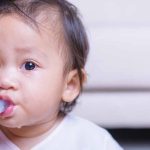Do you feel your baby has suddenly become extra fussy while feeding? If that’s the case, check their mouth and see if there are white patches that weren’t there before. It could be an infection caused by Candida albicans which is a type of yeast and is commonly known as thrush when it’s in the mouth. Oral thrush in babies is the most common fungal infection and though not serious, can get rather uncomfortable as it causes irritation in and around a baby’s mouth.
This yeast can live anywhere on your body without causing any bother but sometimes it may grow out of control. Candida is a dimorphic fungus that depending on the temperature can switch between being a yeast or a mould and is really contagious. This makes it very easy for it to spread, survive and cause oral thrush in babies. This overgrowth of the candida yeast is known as thrush and you will notice white patches in your baby’s mouth and diaper area and in some cases, on your nipples. The good news is that early stage oral thrush can be treated quite easily.
Symptoms and Signs of Oral Thrush in Babies
Oral thrush usually affects babies younger than 6 months old and might show up as cracked skin at the corners of the mouth or white patches on the tongue, gums, inside the cheeks and lips. Thrush typically looks like cottage cheese but it can’t be wiped away. Sometimes, babies may not be able to feed well as they are uncomfortable when sucking because of soreness, but most babies don’t feel any discomfort or pain.
Before you allow the alarm bells to start ringing, do remember that these might not be oral thrush symptoms as milk residue could also cause your baby’s tongue to be white and this would usually disappear within an hour of feeding. You could wrap a piece of gauze around your finger and try to gently wipe away the white patches. If it doesn’t get wiped away, it’s a thrush.
Causes of Oral Thrush in Babies
- Oral thrush in babies often occurs during the first few weeks or months of life. It could happen because infants have a weaker immune system and can’t fight infections well at this stage.
- It has often been seen to follow a course of antibiotics or steroids as they reduce the healthy bacteria in the body making it easier for the yeast to grow.
- It could also be possible that a baby might pick up Candida in the birth canal.
- If the mother had a vaginal yeast infection which can happen because of hormonal changes in pregnancy, it might pass on to the baby during delivery.
Oral Thrush Treatment in Babies
Once you are sure of the diagnosis, the oral thrush treatment needs to begin.
- Though some cases go away after a week or two without medical treatment, visit your doctor as they may prescribe an antifungal solution containing nystatin for your baby’s mouth. This is usually applied with a sponge applicator several times a day for 10 days on the inside of the mouth and tongue.
- Depending on your baby’s age, the doctor might also add yoghurt with lactobacilli to your baby’s diet. Lactobacilli is healthy bacteria that can fight the yeast in your child’s mouth. It’s possible to buy probiotics as a dietary supplement, but make sure to choose a brand that is suitable for babies.
- If your baby gets oral thrush repeatedly, especially if they are older than 9 months, consult your doctor because this might be an indication of some other health issue.
- If your baby has thrush in the diaper area or scalp, you can use over-the-counter antifungals but it’s best to check with your doctor first.
- There are a few home remedies for thrush but do approach them with caution and consider them to be complementary treatments rather than primary treatments. Add half a teaspoon of baking soda in a cup of boiled, cooled water and use it to wipe inside your baby’s mouth. Tea tree oil and virgin coconut oil can be used in the same way. It’s very important to check with your baby’s doctor before using any home remedy for your baby’s thrush, especially in the mouth.
Prevention of Oral Thrush in Babies
Oral thrush in babies is a common infection in babies, but it can be prevented by just keeping a few simple precautions in mind.
- If you use a bottle to feed your baby or use a pacifier, clean the nipples and pacifiers in a dishwasher or in hot water after each use. That way, any yeast on the nipple or pacifier won’t reinfect your baby. Always store milk and prepared bottles in the fridge as that prevents yeast from growing. If you’re pumping breast milk, keep it refrigerated till right before use to prevent the growth of Candida
- If your nipples are red and sore while breastfeeding, you might have a yeast infection on your nipples, which you can pass to your baby and back. Consult your doctor who may suggest an antifungal ointment for your nipples and an antifungal solution for your baby. This is important so that the yeast doesn’t travel from your baby’s mouth to your nipple and back to their mouth.
- Ensure that you wash your baby’s hands, toys and pacifiers frequently.
- Launder your towels, clothing and bras that may have come into contact with the yeast in a hot wash cycle.
- Never skip sterilising your breast pump and its various parts.
- Make sure you dry your breasts after every feeding.
- Avoid disposable nursing pads with a plastic backing as far as possible and remember to change them when they get wet.
- Think about reducing your sugar intake as studies suggest that higher glucose levels may contribute to the growth of Candida yeast.
Having a new baby isn’t always a bed of roses and can be quite unpredictable at times. One minute you might be delighted at your baby’s wide smile and the next you might be wondering what the white patch in their mouth is. While oral thrush symptoms aren’t serious, it can be rather unpleasant for your baby and as a result, for you too. So if the symptoms of thrush persist, pay your paediatrician a visit. With treatment it’ll clear up in a week or two and you and your baby will be back to normal again. If you are looking for more information on oral thrush, its causes, symptoms, oral thrush treatment and prevention, do reach out to EuroKids for updates.
Disclaimer: The information provided on this website is not a substitute for professional medical advice. EuroKids encourages you to consult with a qualified healthcare professional for any health concerns you may have. The information on this website is not intended to diagnose, treat, cure or prevent any disease.
















